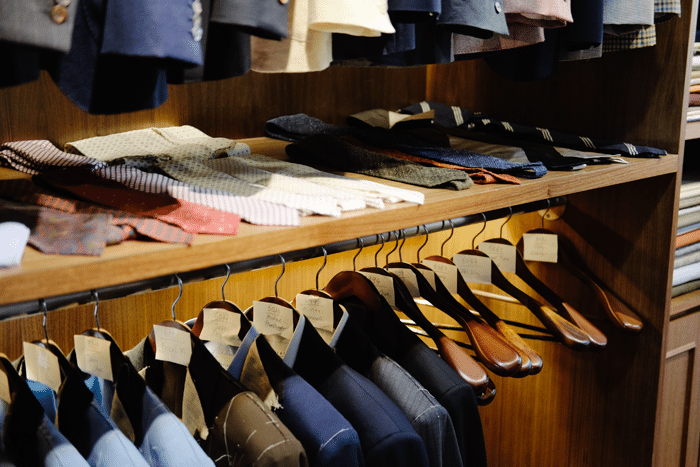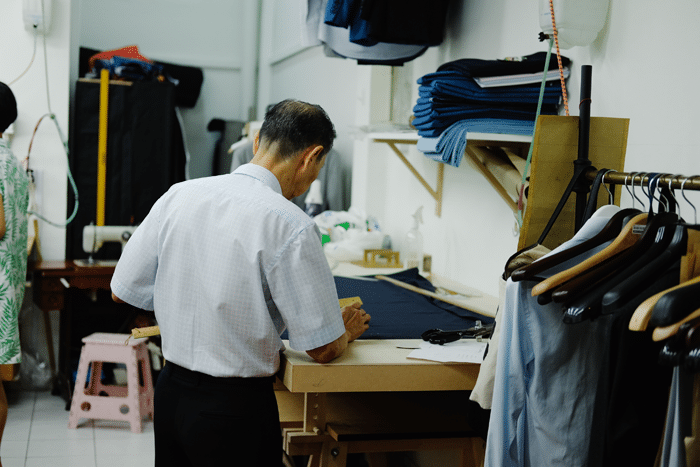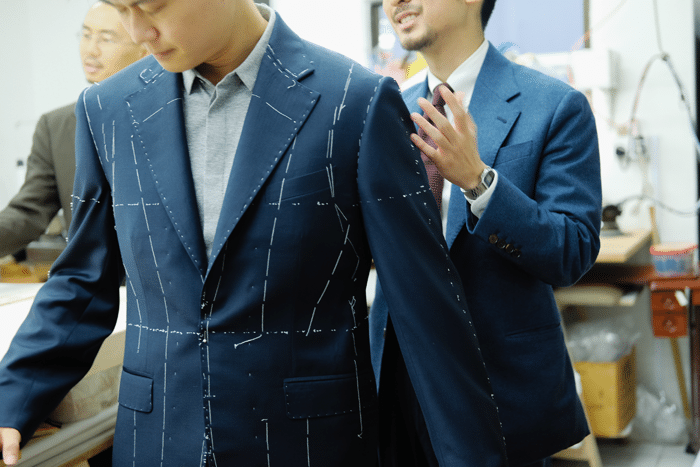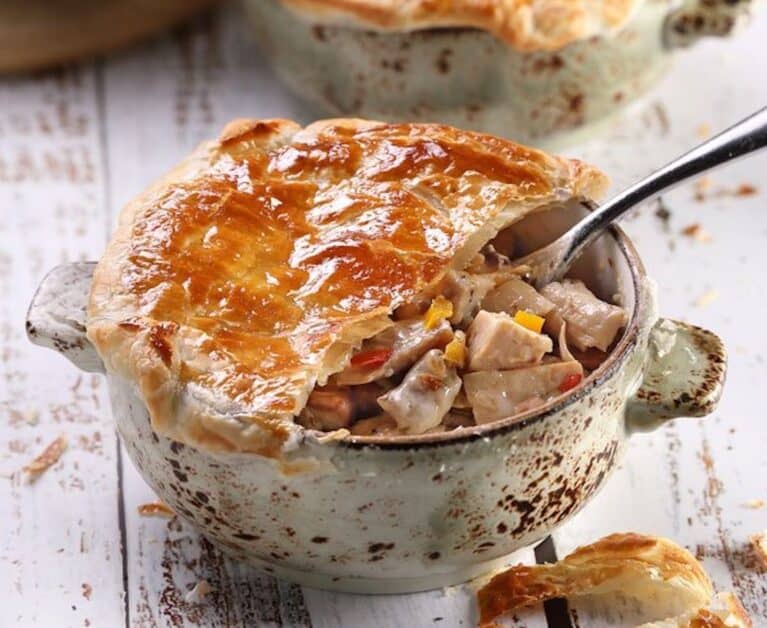10 Questions with KayJen Dylan, Singapore’s Newest Tailoring Collaborative
PUBLISHED April 17th, 2017 06:00 am | UPDATED August 21st, 2023 03:02 pm
Tucked away on the third floor of a heritage shophouse in Telok Ayer is a gentlemen’s haven of sorts; an elegant and almost minimalist space that serves as the tailor shop KayJen Dylan (KJD). The air we breathe in is permeated with the smell of cut fabrics, as we observe a half-century-old Singer sewing machine sitting in one corner, a box of tailor’s chalk nearby.
See our Singaporean men’s guide on how to dress up for work here.
It is here that plenty of young professionals, fresh into the corporate workforce, enter the world of made-to-measure menswear, which is to say – suits, shirts, and trousers. The primary clientele ranges from 23 to 35 years old, and at just 28, KJD’s director Matthew Lai himself fits into that bracket. It’s also the reason the brand delivers a more youthful and contemporary style as compared to the old guards of the industry.
Still, he keeps to the timeless menswear aesthetics of quality fabrics, clean lines, and classic proportions. Dylan Chong, his 36-year-old partner, makes sure of that – having been running his own business Dylan & Son for the last seven years and counting. Together, the pair personally serves their clients, offering advice on style and dressing with full authenticity and transparency.

At the moment, shirts start from around $150, trousers at $200, and full wool-suits start from $1,500. We chat with Matthew and Dylan to find out more about the brand and the made-to-measure menswear scene in Singapore.
Can you tell us more about your collaboration?
Matt: Before I started out, I already knew Dylan. We were acquaintances. He was nice enough to come down to check things out and give tips and tell stories about his experiences. That’s how our friendship grew, and we had weekly meetups for drinks. One day, we decided to work together. The challenge was, he was already six years into the business, so it was difficult to do a full merger. So we thought, Dylan & Son will be the bespoke line, while KJD will focus on made-to-measure clothes. I head KJD and run the daily operations, and Dylan will still handle his business.
Dylan: It’s also a sharing of resources. If he was carrying on his own, there would be progress, but it’d be very slow paced. So what we did with this merger and the incorporation of the workshop, was to accelerate this progress.
When did you guys start going into menswear?
Matt: It was right after National Service. I graduated from LASALLE’s Fashion Design programme, and I managed to land an internship at a tailor shop. From there, I grew to like tailoring. And it sounds a bit cliche, but it’s reality. A lot of big local brands come and go, and didn’t survive over the years – brands like Raoul. I saw that some tailor shops have been around for 30 years, so something must be going on there, right?
Dylan: I also graduated from LASALLE, the same programme, and after that, I took over my dad’s existing tailor business, Oriental Tailor. That was seven years ago in 2010.
Surely there must be someone who inspires you when it comes to tailoring. Who is that person?
Dylan: Tailors that we admire highly include a Taiwanese tailor called Chen Ho-ping, and Singapore’s master tailor Thomas Wong. We also like the style of the Korean tailors, like Generico. These are the people we want to emulate.

You mentioned Korean tailors. What are their cuts and fit like?
Dylan: In my opinion, they are very Italian-influenced. The Koreans are especially good in two critical aspects: technique and aesthetics. You can have the best suit cut and fabric, but if you give it a terrible colour, or if the style is a bit off, it doesn’t look good. Or you can have a very good visual style, but if it’s made in a poor construction, it doesn’t work either. The Koreans master this extremely well.
What should people know before stepping into a tailor shop?
Matt: I guess they should be mentally prepared with regard to what looks good to them, what colours they’re looking for, and what kind of wardrobe they want to build. We can’t mind-read them to know what they like, how slim they want their pants, how big or tapered they want it. So firstly, do a bit of research into the style they like, and try to come dressed in a shirt and pants, as well as proper shoes, so the measurements will be more accurate.
What is one thing you’re tired of hearing from customers?
Matt: “I want non-creasy shirts.” I think that’s impossible to do.
Dylan: Something that doesn’t work for them. I always use hair as an example. Me, with my high hairline and very sparse hair, I can’t go into the barbershop asking for a ponytail. So it’s the same, if you’re very athletic and you’re a body-builder, you can’t expect to look like that guy *points to a photo of a slender man in a slim suit*. It’s a different body structure altogether. You’ll look awesome in a muscle tee, but in a suit, not so much. Sometimes you can’t have your cake and eat it too.
Let’s say you’re in the CBD. What do you dislike about the way most men are dressed nowadays?
Matt: My pet peeve? They wear their pants too low on their hip bone. It’s too tight, and you can even see the fats exploding out. That’s the biggest turn-off. Plus, a lot of them wear black pants, lavender shirts, and brown shoes. It’s all the same.
Dylan: I think it’s a misconception that black is the easiest colour to go with. In fact, it’s the toughest because it’s so difficult to match with anything else. With a white shirt the contrast is too stark. So we recommend black pants only for three occasions: number one, tuxedos; number two, if you’re a lawyer, and number three; funerals.

In that case, what are some simple fixes to mixing things up?
Dylan: A lot of people are too caught up in trying to stand out. We suggest a pair of grey trousers, light blue shirt, and a dark blue tie. It’s simple, but somehow it just looks different. What is that factor that makes it look so good, that makes it pop out, that makes a random person on the street think “that is nice”? That’s what we’re trying to achieve here, that certain element.
Matt: It’s not just about the colour of your buttonhole and stuff, but also about the different textures and subtleties, like a different shade of white, a different weaving, the proportions. All of these play a part in the assembly.
Name a couple of style rules that you swear by.
Matt: Always wear your trousers on your natural waist.
Dylan: Yeah, it’s not necessary to go high, but you shouldn’t go low. It always looks better when you wear your pants at an appropriate height. For me, it’s very important to iron your trousers. It instantly looks better, I guarantee you that. I press everything, even my jeans. Because it looks linear and slimmer. And always polish your shoes. It’s no good if you buy a very expensive pair of shoes, but don’t polish it.
How about five essentials in every man’s wardrobe?
Matt: A navy suit. A crisp white shirt. Grey wool trousers – it’s the most versatile. A well-constructed pair of leather shoes, and a good pair of cotton chinos. Oh, and ties too. Ties are nice.
KayJen Dylan is located at 120 Telok Ayer St, Singapore 068589, p. +65 6221 1852. Open Mon-Fri 12pm – 8pm, Sat 12pm – 5pm. Closed Sun. By appointment only.

